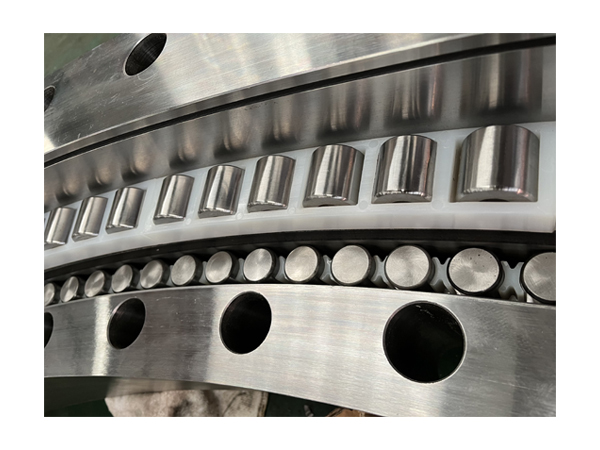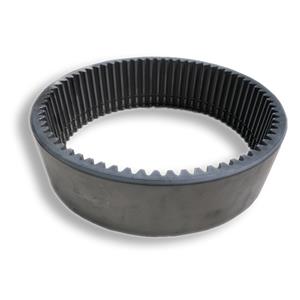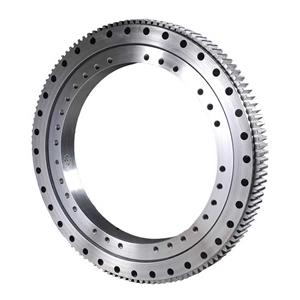Detailed explanation of slewing bearing structure and working principle
Detailed explanation of slewing bearing structure and working principle
The slewing bearing is also called slewing ring, swing bearing or turntable bearing. It is usually with a diameter ranging from 0.2 to 10 meters. It is a large bearing that can withstand axial and radial loads and overturning moments. The slewing ring bearing is composed of mounting holes, inner gear ring or outer gear ring, spacer block, cage, lubricating oil hole and sealing device, so it can make the design of the main engine compact, easy to guide and maintain.

1). Slewing bearing structure
The rolling elements of the slewing bearing are usually separated by nylon spacers. This structure can maintain the stability of movement, and is widely used because of its low price. Special application occasions need to use special ball or roller spacers, such as copper, aluminum and other high temperature isolation blocks. Bearings usually installed on horizontal shafts or continuously rotating generators and slewing bearings used in occasions with high requirements on positioning and reliability, a strip-shaped combined cage can be used to keep the rolling elements in the correct position. Circumferential position, higher reliability.
2). Reasons and solutions for heating caused by structural factors of slewing bearing
Reason: The shaft size of the slewing bearing is too large, so the bearing will be tight.
Solution: Provide proper tolerance for the shaft, and it is strictly forbidden to be too tight.
Reason 2: The aluminum three-layer annular sealing ring has friction and causes heat.
Solution: When installing the sealing hole and the ring, grease should be applied to reduce frictional resistance.
Reason 3: The slewing bearing seat is coated with too much grease or the oil level is too high Solution: The slewing bearing will remove excess grease through the sealing hole, and oil lubrication will reduce the oil level to just below the bearing housing.
Reason 4: The inner ring and the sealing ring are rubbed and heated.
Solution: At this time, stop the machine and check the clamping ring screws to ensure that the inner ring is firmly attached to the shaft, ensure that the free bearing is installed correctly, and the rollers are aligned with the center line of the outer ring.
In addition to the structural reasons of the slewing bearing, there are other reasons that cause heat, as follows:
Reason 5: Lubricant failure caused by improper type of grease or lubricating oil Solution: Re-select the appropriate lubricating oil type.
Reason 6: Low oil level and insufficient grease Solution: The oil level outside the shaft diameter should be just lower than the cage, and appropriate grease should be added.
Of course, there may be many reasons for the overheating of the slewing bearing. In order to ensure the normal use of the slewing bearing, I hope that when you encounter the overheating of the slewing bearing, you can stop the slewing bearing to check in time, find out the cause and deal with it, so as to prevent the service life of the slewing bearing.
3). Working principle of slewing bearing
The working principle of the slewing bearing is very simple: the way to move the object is to change from sliding to rolling, reducing frictional resistance.
Specifically, the slewing bearing mainly relies on lubrication and friction to achieve the effect of operation. Internally, it relies on the mutual friction between the ball and the steel ring to achieve the purpose of operation. Externally, it also relies on the friction between the slewing ring bearing and other components to start the operation and rub against each other, thereby driving the object to operate. Since it is mostly used to carry heavier large objects, its centripetal force is very high, which is also determined by its working principle, so it also needs a steel material that can ensure quality in terms of materials.
Of course, friction alone is not enough. Although it relies on friction to operate, lubrication is also essential. Just like the chain of a bicycle, if it is used for a long time and the friction is too large, it will also affect the use of parts. Therefore, after using this kind of bearing for a period of time, it is necessary to maintain it in time and brush some lubricating oil to ensure that it can work well in a more suitable environment.
4). Several basic forms of slewing bearing working methods
1. Point contact rolling working mode of slewing bearing
The point-contact rolling working mode is mainly used for four-point contact ball slewing bearing and cross-roller slewing bearing. This working principle has high requirements on the quality of the steel ball for the combined bearing of point contact radial and axial forces, and the angle of the track should be uniform.
2. Surface contact rolling combined working mode of slewing bearing
The surface contact rolling combined working mode is mainly used for three-row roller slewing bearings. Its advantage is that the contact surface is large and the bearing force is uniform and rolling.
3. Surface contact rolling and sliding combined working mode of slewing bearing
The surface-contact rolling-slip combined working method is mainly used for turntable bearings. Now the new type of turntable bearing has a compact structure and high precision. Therefore, it is suitable to use the surface-contact rolling-slip combined working method.
4. Rolling and sliding combined rolling working mode of slewing bearing
The main rolling-slip combined rolling working mode is mainly used for the ball-column combined slewing bearing. This principle has the advantages of small eccentricity and long service life, and has the advantages of the dual structure of rollers and balls.

5), Daily maintenance
1. Maintenance of the slewing bearing After 100 working hours, check the pre-tightening torque of the secondary bolts.
2. If more than 10% of the bolts are loose, check again after 200 working hours.
3. In the future, check every 500 working hours; in severe working conditions, the inspection interval should be shortened.
4. After the equipment has been working for 2000 hours, if a bolt is found to be loose to less than 80% of the specified torque, the bolt and the two adjacent bolts should be replaced with new ones.
5. If 20% of the bolts are found to be loose to less than 80% of the specified torque, the bolts should be replaced with new ones.
6. After the equipment has been working for 14,000 hours, the bolts must be replaced with new ones.
7. For equipment with high rotation speed or continuous rotation or frequent work, add oil every 100 working hours.
8. In the case of bad working conditions, it is necessary to shorten the time interval for filling lubricating grease.
Each component has its basic structural construction and related construction principles, especially for a new type of mechanical component, the slewing bearing. At the same time, more fields of application are given.




